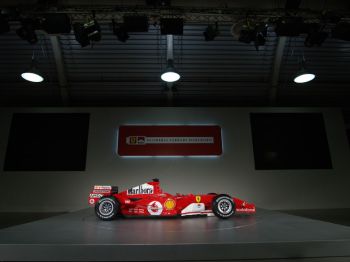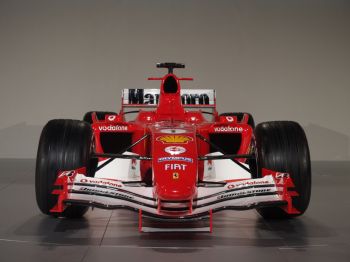|
The F2005 is the
fifty first single-seater built by Ferrari specifically to
compete in the Formula 1 World Championship. The design,
which bears the internal code number 656, represents
Ferrari’s more exhaustive interpretation of the 2005
technical regulations. The main elements, relating to
aerodynamics are more advanced than on the F2004 M.
The chassis is lighter, despite the need to strengthen the
lateral anti-intrusion panels within the monocoque to
increase its ability to meet the requirements of the
crash-test, which is stricter than in the past.
The shape has been revised, with modifications to the
opening of the side pods and the area around the turning
vanes. The side pods have been adapted to accommodate the
new cooling system.
The engine cover has been redesigned, as have the
aerodynamic devices on the side pods, with a secondary
winglet introduced in the area of the roll-hoop. The layout
of the exhausts is fundamentally different to that of the
previous car, eliminating the aerodynamic profile which
characterised the rear section, which is now almost entirely
integrated within the bodywork.
While retaining the longitudinal architecture for the
transmission, the entire rear end has been changed in an
attempt to get the most out of the size of the gearbox,
which is smaller than its predecessor and made from titanium
and carbon fibre. Naturally, the limitations introduced by
the new regulations were taken into account during the
design stage.
The rear suspension has been revised, with the twin aims of
improving the car’s dynamics in order to optimise the
efficiency of operation for the Bridgestone tyres, while
also improving the aerodynamic efficiency of the rear. The
floor of the car has also been substantially redesigned to
fit in with the new dimensions of the gearbox and comply
with the new regulations. Two areas that benefited from a
major effort during the design stage were the braking and
electronics systems, this work carried out in conjunction
with technical partners.
The 055 engine is load-bearing and mounted longitudinally.
Much of the internal componentry derives from the last
version of the 053, currently fitted to the F2004 M.
|
 |
|
|
|
 |
|
|
|
The main changes centre on the mounting points to chassis
and gearbox. Its designers aimed to come up with an engine
able to maintain a sufficient level of performance, doubling
its life given that the sporting regulations introduced this
year require the use of the same engine for two consecutive
race weekends. As always, Shell’s help has been invaluable
in the definition of fuel and lubricants to best meet the
set targets.
The F2005 represents the final evolution in a line of
Ferrari Formula 1 cars fitted with a ten cylinder engine. As
usual, right from the design stage, much attention was paid
to performance and optimisation of the materials used as
well as quality control, in order to increase performance
levels with maximum safety, all within the framework of the
new rules introduced this year.
CHASSIS
Carbon-fibre and honeycomb composite structure
Ferrari longitudinal gearbox limited-slip differential
Semiautomatic sequential electronically controlled gearbox
Number of gears 7 + reverse
Ventilated carbon-fibre disc brakes
Independent suspension, push-rod activated torsion springs
front and rear
Length 4545 mm
Width 1796 mm
Height 959 mm
Wheelbase 3050 mm
Front track 1470 mm
Rear track 1405 mm
Weight with water, lubricant and driver 605 kg
Wheels (front and rear) 13”
ENGINE
Type 055
Number of cylinders V 10
Cilinder block in cast aluminium
Number of valves 40
Pneumatic distribution
Total displacement 2997 cm3
Magneti Marelli digital electronic injection
Magneti Marelli static electronic ignition |
|
![]()
![]()